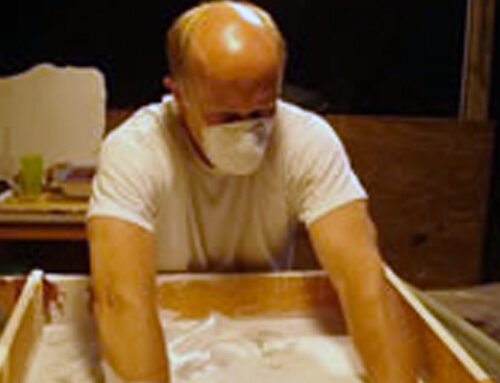A Glass Work In Progress | Part II
Questions And Answers – A Conversation with Mike Leckie, Sculptor
MAY 21 – 2007

Q: Why is cleaning the mold important?
Mike: I use water based clay. Any powder from the clay is an enemy of the wax because it will stay as a residue on the inside of the mold when the wax melts out. Any little piece of dirt in the mold comes out as a negative pit in the glass.
 Q: What kind of wax do you use?
Q: What kind of wax do you use?
Mike: It’s called pattern wax and I buy it from a foundry supply house. It is a little more like plastic than wax people are familiar with because this one doesn’t shrink as much as the other waxes.
 Q: Why is that important?
Q: Why is that important?
Mike: You want to be able to hold all the detail and all the edges of the piece you’ve just created. If you lose them they won’t end up in the final piece. What you want to end up with is an exact replica. You want the wax to have as crisp edges and as good a surface as you want in the final piece.
 Q: Is there a trick to pouring wax into the mold?
Q: Is there a trick to pouring wax into the mold?
Mike: Yes (chuckling) there are several tricks. There are people who make a complete career out of pouring wax. Wax should be at appropriate temperature. You have to have your mold warm. If you…pour, stop….pour, stop…pour, stop you get a bunch of lines called chill lines that look like lines in a piece of wood.
You want your wax to have no bubbles when you pour and you want to pour slowly and carefully. If you get a little wild and splash wax you get bubbles and the bubbles will all show up in the surface of your piece. You don’t want that.
I pour in a small amount and then roll it around on the inside of the mold and get a real good surface coat. Some people fill up the mold. There’s less possibility of spilling a lot of wax the way I do it.
 Q: What was it like taking the rubber off and seeing what was behind it?
Q: What was it like taking the rubber off and seeing what was behind it?
Mike: It’s a quiet thrill because I get to look at the standing art for the first time because it’s been laying down and I don’t get to see it standing up until that moment. That’s a thrill, but the quiet part is that I’m very aware that there is a lot of process left to go. There are still six more processes left to go before we end up with glass.
The reason we make the wax model is that this is the lost wax casting process. Lost wax is very old. It’s called lost because the wax leaves the mold and leaves a perfect impression that then is filled with metal or glass. It’s a very ancient technique, mostly used in metal, making a plaster mold around wax, melting it out and pouring metal in the hot mold.. An old technique of making a plaster mold around wax, melting it out and putting wax in there. We’re talking thousands of years.

I do it that way because the detail that you can attain from the wax model that’s copied by the plaster mold is very tight…extreme detail. This very same thing is being done to cast gold jewelry around African campfires using beeswax and mud.


